steering MAZDA MAZDA 2023 User Guide
[x] Cancel search | Manufacturer: MAZDA, Model Year: 2023, Model line: MAZDA, Model: MAZDA MAZDA 2023Pages: 623, PDF Size: 15.08 MB
Page 73 of 623
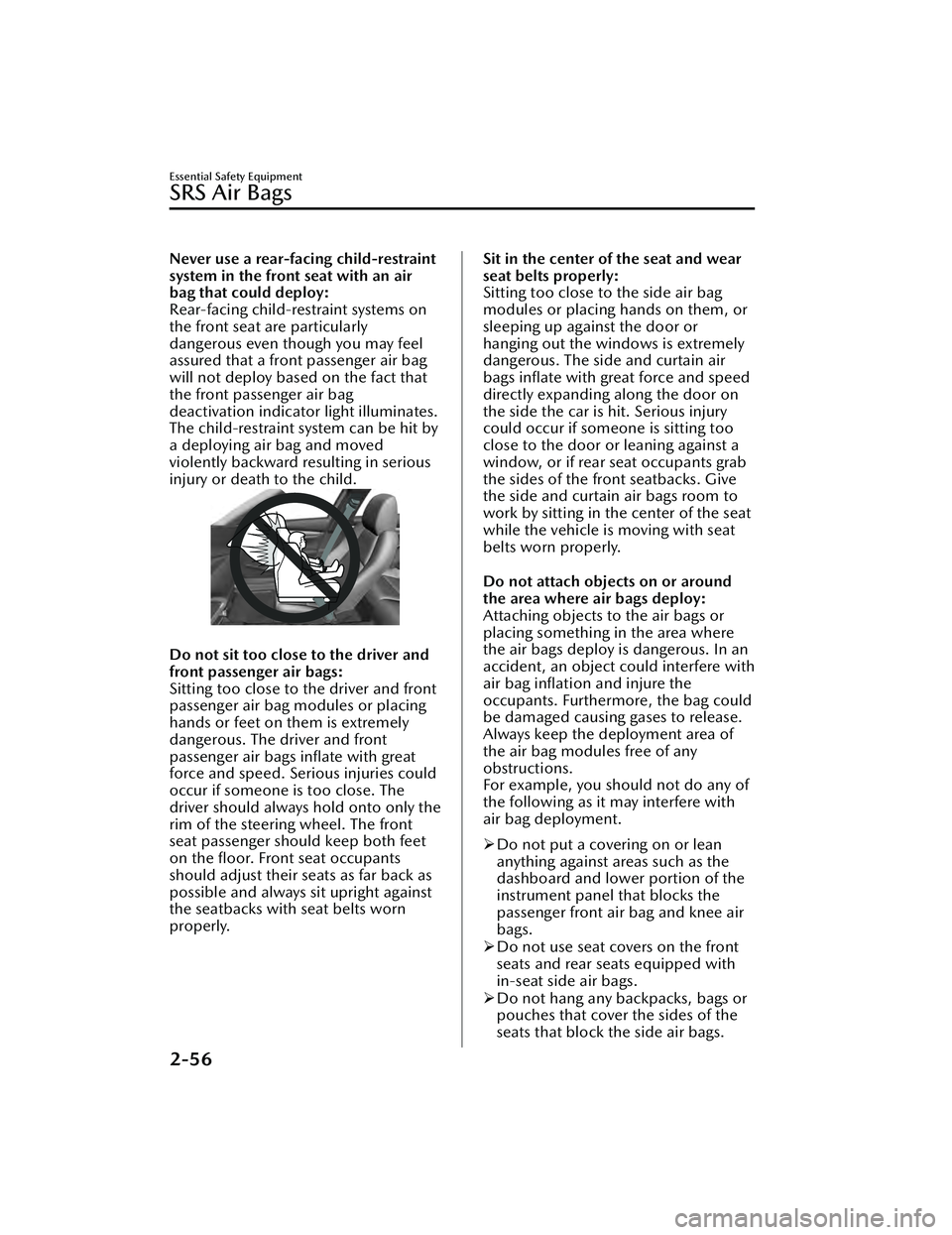
Never use a rear-facing child-restraint
system in the front seat with an air
bag that could deploy:
Rear-facing child-restraint systems on
the front seat are particularly
dangerous even though you may feel
assured that a front passenger air bag
will not deploy based on the fact that
the front passenger air bag
deactivation indicator light illuminates.
The child-restraint system can be hit by
a deploying air bag and moved
violently backward resulting in serious
injury or death to the child.
Do not sit too close to the driver and
front passenger air bags:
Sitting too close to the driver and front
passenger air bag modules or placing
hands or feet on them is extremely
dangerous. The driver and front
passenger air bags inflate with great
force and speed. Serious injuries could
occur if someone is too close. The
driver should always hold onto only the
rim of the steering wheel. The front
seat passenger should keep both feet
on the floor. Front seat occupants
should adjust their seats as far back as
possible and always sit upright against
the seatbacks with seat belts worn
properly.
Sit in the center of the seat and wear
seat belts properly:
Sitting too close to the side air bag
modules or placing hands on them, or
sleeping up against the door or
hanging out the windows is extremely
dangerous. The side and curtain air
bags inflate with great force and speed
directly expanding along the door on
the side the car is hit. Serious injury
could occur if someone is sitting too
close to the door or leaning against a
window, or if rear seat occupants grab
the sides of the front seatbacks. Give
the side and curtain air bags room to
work by sitting in the center of the seat
while the vehicle is moving with seat
belts worn properly.
Do not attach objects on or around
the area where air bags deploy:
Attaching objects to the air bags or
placing something in the area where
the air bags deploy is dangerous. In an
accident, an object could interfere with
air bag inflation and injure the
occupants. Furthermore, the bag could
be damaged causing gases to release.
Always keep the deployment area of
the air bag modules free of any
obstructions.
For example, you should not do any of
the following as it may interfere with
air bag deployment.
Do not put a covering on or lean
anything against areas such as the
dashboard and lower portion of the
instrument panel that blocks the
passenger front air bag and knee air
bags.
Do not use seat covers on the front
seats and rear seats equipped with
in-seat side air bags.
Do not hang any backpacks, bags or
pouches that cover the sides of the
seats that block the side air bags.
Essential Safety Equipment
SRS Air Bags
2-56
Mazda3_8LC2-EA-22G_Edition1_new 2022-5-20 11:26:10
Page 75 of 623
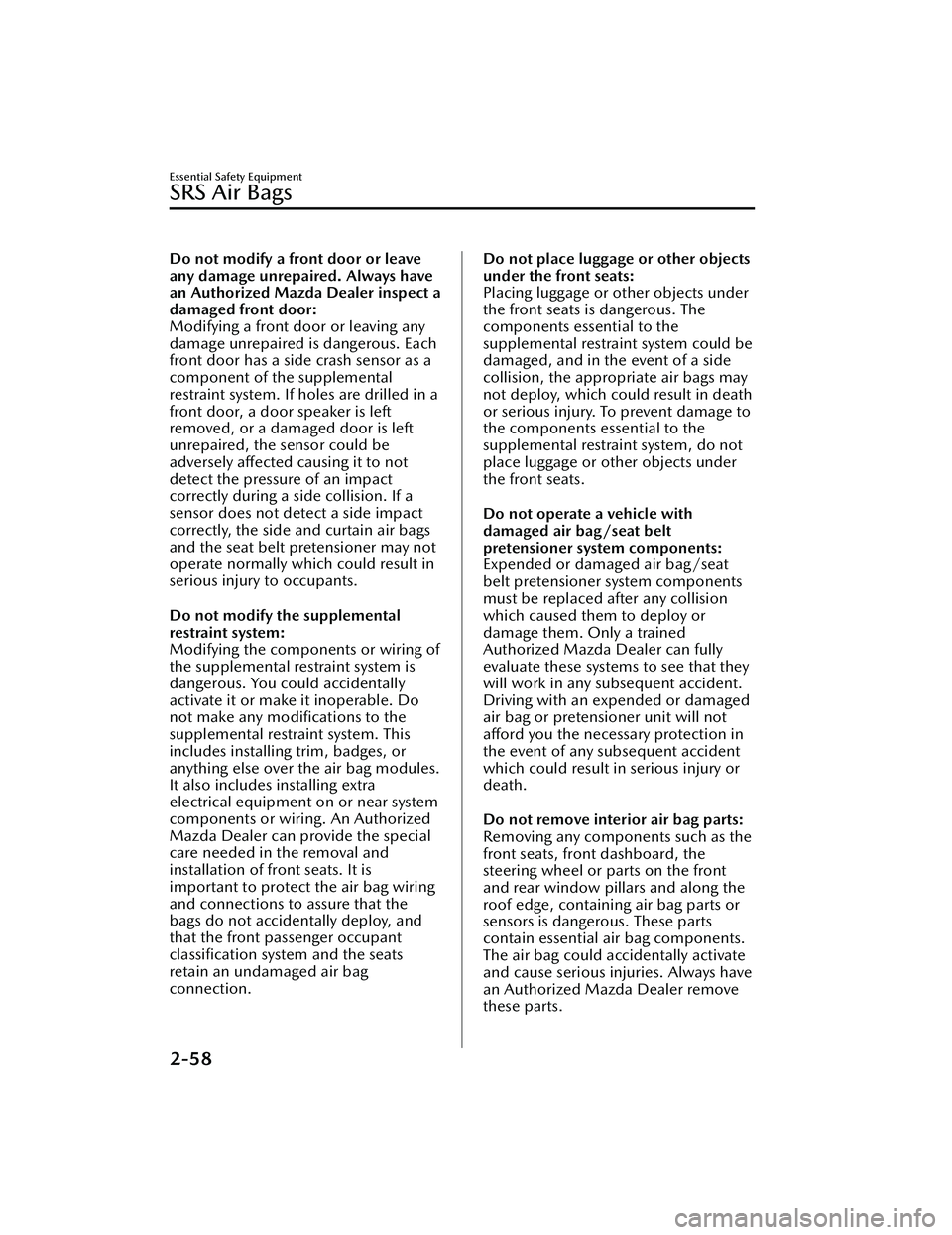
Do not modify a front door or leave
any damage unrepaired. Always have
an Authorized Mazda Dealer inspect a
damaged front door:
Modifying a front door or leaving any
damage unrepaired is dangerous. Each
front door has a side crash sensor as a
component of the supplemental
restraint system. If holes are drilled in a
front door, a door speaker is left
removed, or a damaged door is left
unrepaired, the sensor could be
adversely affected causing it to not
detect the pressure of an impact
correctly during a side collision. If a
sensor does not detect a side impact
correctly, the side and curtain air bags
and the seat belt pretensioner may not
operate normally which could result in
serious injury to occupants.
Do not modify the supplemental
restraint system:
Modifying the components or wiring of
the supplemental restraint system is
dangerous. You could accidentally
activate it or make it inoperable. Do
not make any modifications to the
supplemental restraint system. This
includes installing trim, badges, or
anything else over the air bag modules.
It also includes installing extra
electrical equipment on or near system
components or wiring. An Authorized
Mazda Dealer can provide the special
care needed in the removal and
installation of front seats. It is
important to protect the air bag wiring
and connections to assure that the
bags do not accidentally deploy, and
that the front passenger occupant
classification system and the seats
retain an undamaged air bag
connection.Do not place luggage or other objects
under the front seats:
Placing luggage or other objects under
the front seats is dangerous. The
components essential to the
supplemental restraint system could be
damaged, and in the event of a side
collision, the appropriate air bags may
not deploy, which could result in death
or serious injury. To prevent damage to
the components essential to the
supplemental restraint system, do not
place luggage or other objects under
the front seats.
Do not operate a vehicle with
damaged air bag/seat belt
pretensioner system components:
Expended or damaged air bag/seat
belt pretensioner system components
must be replaced after any collision
which caused them to deploy or
damage them. Only a trained
Authorized Mazda Dealer can fully
evaluate these systems to see that they
will work in any subsequent accident.
Driving with an expended or damaged
air bag or pretensioner unit will not
afford you the necessary protection in
the event of any subsequent accident
which could result in serious injury or
death.
Do not remove interior air bag parts:
Removing any components such as the
front seats, front dashboard, the
steering wheel or parts on the front
and rear window pillars and along the
roof edge, containing air bag parts or
sensors is dangerous. These parts
contain essential ai r bag components.
The air bag could accidentally activate
and cause serious injuries. Always have
an Authorized Mazda Dealer remove
these parts.
Essential Safety Equipment
SRS Air Bags
2-58
Mazda3_8LC2-EA-22G_Edition1_new 2022-5-20 11:26:10
Page 79 of 623
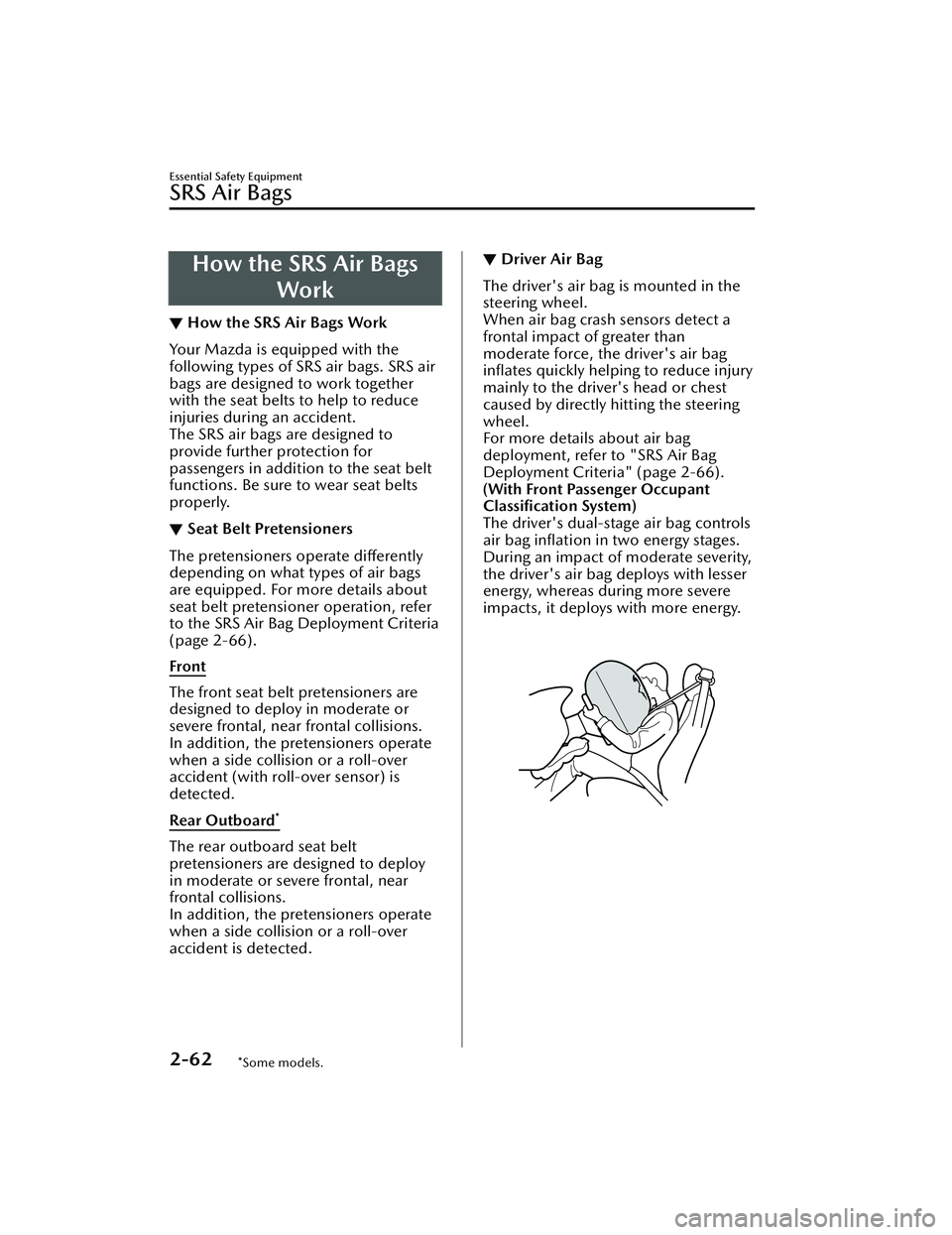
How the SRS Air BagsWork
▼How the SRS Air Bags Work
Your Mazda is equipped with the
following types of SRS air bags. SRS air
bags are designed to work together
with the seat belts to help to reduce
injuries during an accident.
The SRS air bags are designed to
provide further protection for
passengers in addition to the seat belt
functions. Be sure to wear seat belts
properly.
▼Seat Belt Pretensioners
The pretensioners operate differently
depending on what types of air bags
are equipped. For more details about
seat belt pretensioner operation, refer
to the SRS Air Bag Deployment Criteria
(page 2-66).
Front
The front seat belt pretensioners are
designed to deploy in moderate or
severe frontal, near frontal collisions.
In addition, the pretensioners operate
when a side collision or a roll-over
accident (with roll-over sensor) is
detected.
Rear Outboard
*
The rear outboard seat belt
pretensioners are designed to deploy
in moderate or severe frontal, near
frontal collisions.
In addition, the pretensioners operate
when a side collision or a roll-over
accident is detected.
▼
Driver Air Bag
The driver's air bag is mounted in the
steering wheel.
When air bag crash sensors detect a
frontal impact of greater than
moderate force, the driver's air bag
inflates quickly helping to reduce injury
mainly to the driver's head or chest
caused by directly hitting the steering
wheel.
For more details about air bag
deployment, refer to "SRS Air Bag
Deployment Criteria" (page 2-66).
(With Front Passenger Occupant
Classification System)
The driver's dual-stage air bag controls
air bag inflation in two energy stages.
During an impact of moderate severity,
the driver's air bag deploys with lesser
energy, whereas during more severe
impacts, it deploys with more energy.
Essential Safety Equipment
SRS Air Bags
2-62*Some models.
Mazda3_8LC2-EA-22G_Edition1_new
2022-5-20 11:26:10
Page 86 of 623
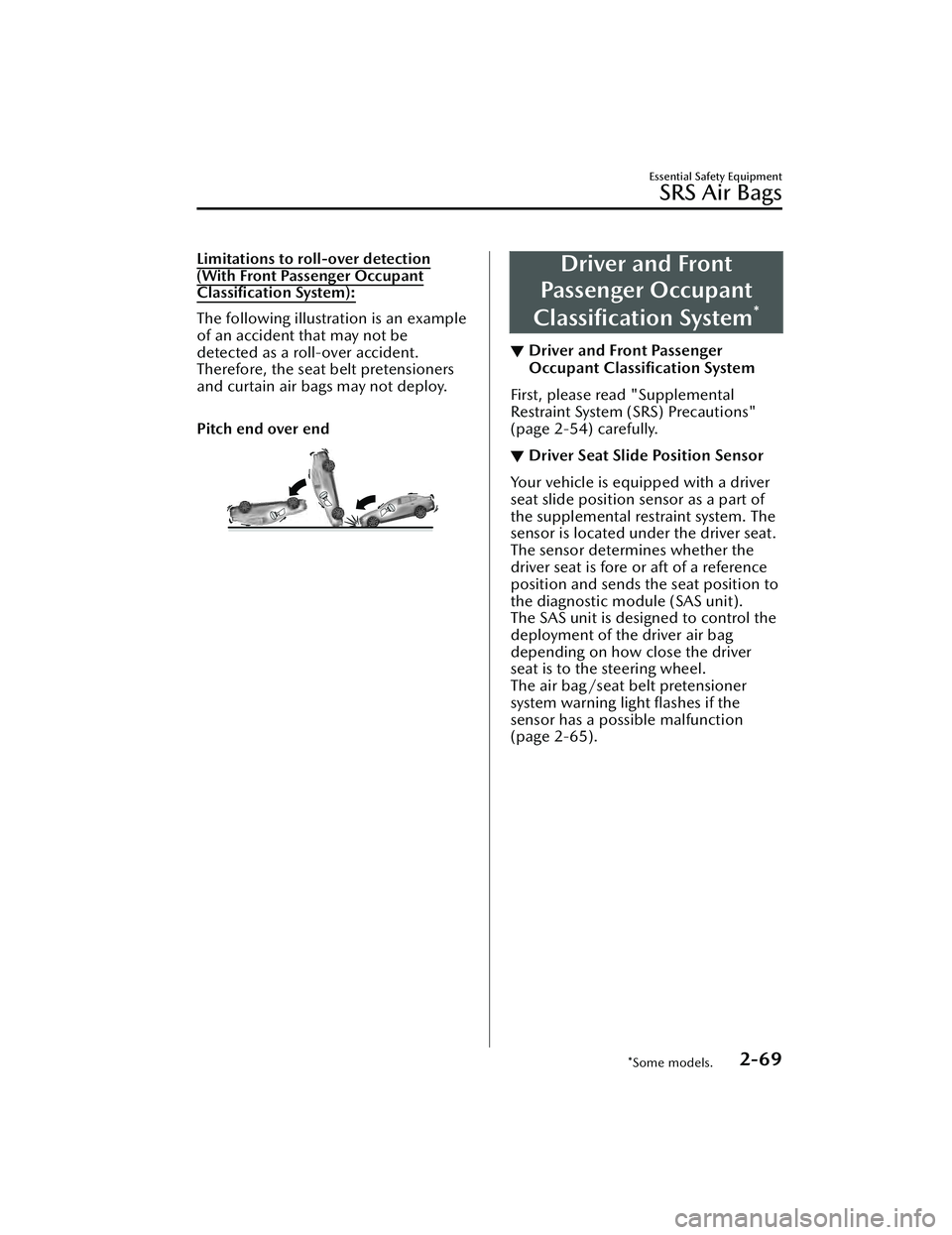
Limitations to roll-over detection
(With Front Passenger Occupant
Classification System):
The following illustration is an example
of an accident that may not be
detected as a roll-over accident.
Therefore, the seat belt pretensioners
and curtain air bags may not deploy.
Pitch end over end
Driver and Front
Passenger Occupant
Classification System
*
▼ Driver and Front Passenger
Occupant Classification System
First, please read "Supplemental
Restraint System (SRS) Precautions"
(page 2-54) carefully.
▼Driver Seat Slide Position Sensor
Your vehicle is equipped with a driver
seat slide position sensor as a part of
the supplemental restraint system. The
sensor is located under the driver seat.
The sensor determines whether the
driver seat is fore or aft of a reference
position and sends the seat position to
the diagnostic module (SAS unit).
The SAS unit is designed to control the
deployment of the driver air bag
depending on how close the driver
seat is to the steering wheel.
The air bag/seat belt pretensioner
system warning light
flashes if the
sensor has a possible malfunction
(page 2-65).
Essential Safety Equipment
SRS Air Bags
*Some models.2-69
Mazda3_8LC2-EA-22G_Edition1_new 2022-5-20 11:26:10
Page 138 of 623
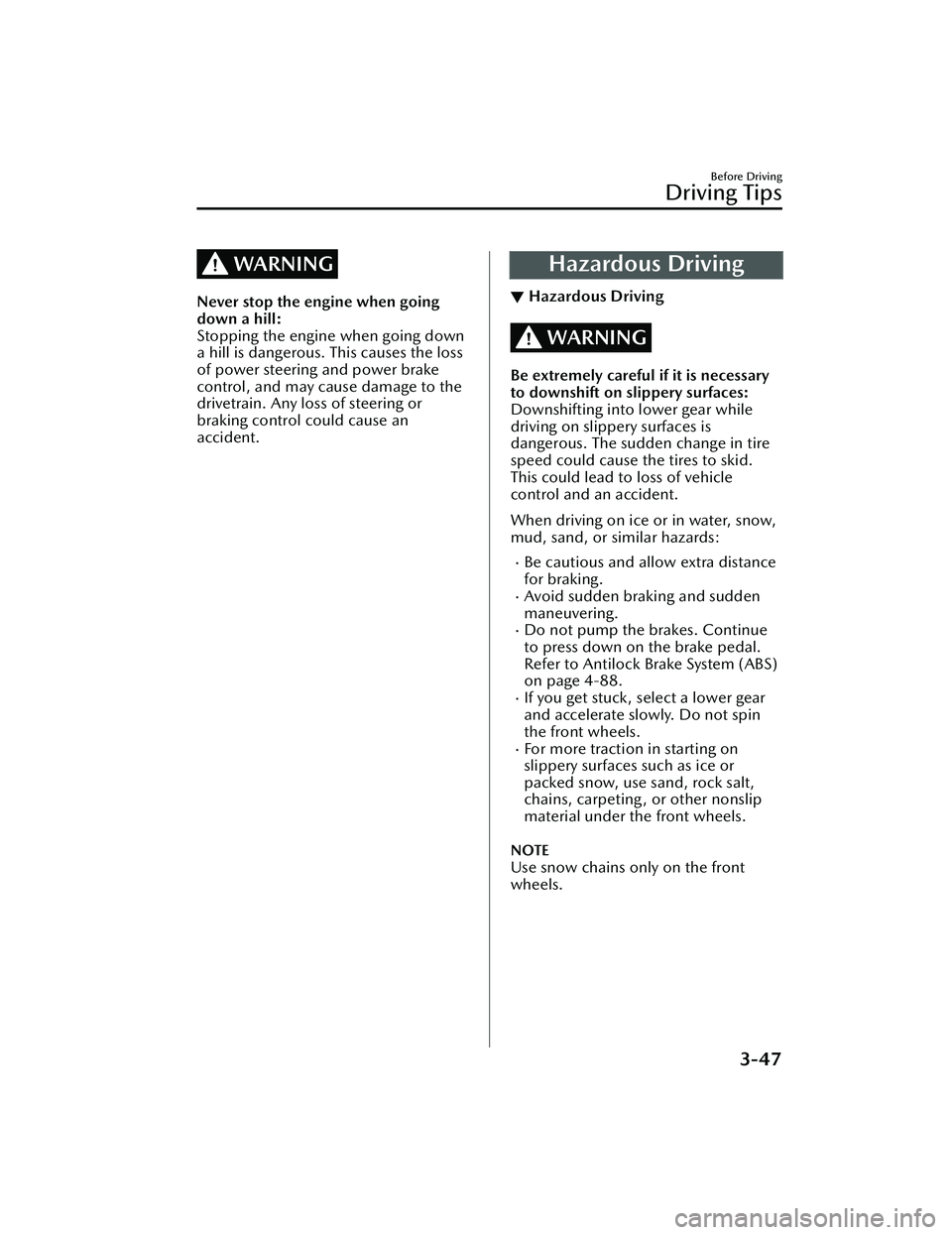
WARNING
Never stop the engine when going
down a hill:
Stopping the engine when going down
a hill is dangerous. This causes the loss
of power steering and power brake
control, and may cause damage to the
drivetrain. Any loss of steering or
braking control could cause an
accident.
Hazardous Driving
▼Hazardous Driving
WARNING
Be extremely careful if it is necessary
to downshift on slippery surfaces:
Downshifting into lower gear while
driving on slippery surfaces is
dangerous. The sudden change in tire
speed could cause the tires to skid.
This could lead to loss of vehicle
control and an accident.
When driving on ice or in water, snow,
mud, sand, or similar hazards:
Be cautious and allow extra distance
for braking.
Avoid sudden braking and sudden
maneuvering.
Do not pump the brakes. Continue
to press down on the brake pedal.
Refer to Antilock Brake System (ABS)
on page 4-88.
If you get stuck, select a lower gear
and accelerate slowly. Do not spin
the front wheels.
For more traction in starting on
slippery surfaces such as ice or
packed snow, use sand, rock salt,
chains, carpeting , or other nonslip
material under the front wheels.
NOTE
Use snow chains only on the front
wheels.
Before Driving
Driving Tips
3-47
Mazda3_8LC2-EA-22G_Edition1_new
2022-5-20 11:26:10
Page 146 of 623
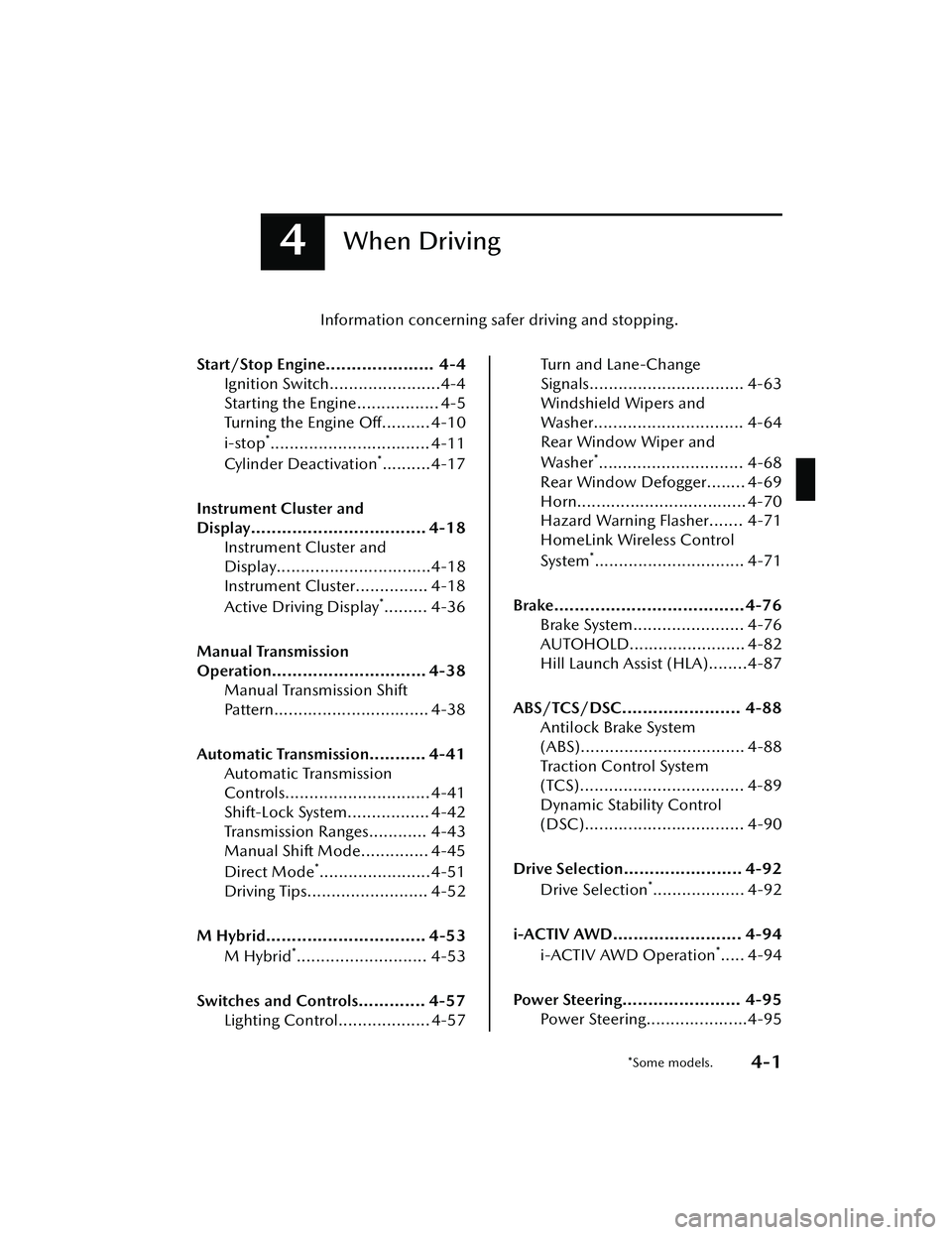
4When Driving
Information concerning safer driving and stopping.
Start/Stop Engine..................... 4-4 Ignition Switch.......................4-4
Starting the Engine................. 4-5
Turning the Engine Off.......... 4-10
i-stop
*................................. 4-11
Cylinder Deact ivat ion
*..........4-17
Instrument Cluster and
Display.................................. 4-18 Instrument Cluster and
Display................................4-18
Instrument Cluster............... 4-18
Active Driving Display
*......... 4-36
Manual Transmission
Operation.............................. 4-38 Manual Transmission Shift
Pattern................................ 4-38
Automatic Transmission........... 4-41 Automatic Transmission
Controls.............................. 4-41
Shift-Lock System................. 4-42
Transmission Ranges............ 4-43
Manual Shift Mode.............. 4-45
Direct Mode
*.......................4-51
Driving Tips......................... 4-52
M Hybrid............................... 4-53 M Hybrid
*........................... 4-53
Switches and Controls............. 4-57 Lighting Control................... 4-57
Turn and Lane-Change
Signals................................ 4-63
Windshield Wipers and
Washer............................... 4-64
Rear Window Wiper and
Washer
*.............................. 4-68
Rear Window Defogger........ 4-69
Horn................................... 4-70
Hazard Warning Flasher....... 4-71
HomeLink Wireless Control
System
*............................... 4-71
Brake.....................................4-76 Brake System....................... 4-76
AUTOHOLD........................ 4-82
Hill Launch Assist (HLA)........4-87
ABS/TCS/DSC....................... 4-88 Antilock Brake System
(ABS).................................. 4-88
Tra c t i o n C o n t r o l Sy s t e m
(TCS).................................. 4-89
Dynamic Stability Control
(DSC)................................. 4-90
Drive Selection....................... 4-92 Drive Selection
*................... 4-92
i-ACTIV AWD......................... 4-94 i-ACTIV AWD Operation
*..... 4-94
Power Steering....................... 4-95 Power Steering.....................4-95
*Some models.4-1
Mazda3_8LC2-EA-22G_Edition1_new 2022-5-20 11:26:10
Page 158 of 623
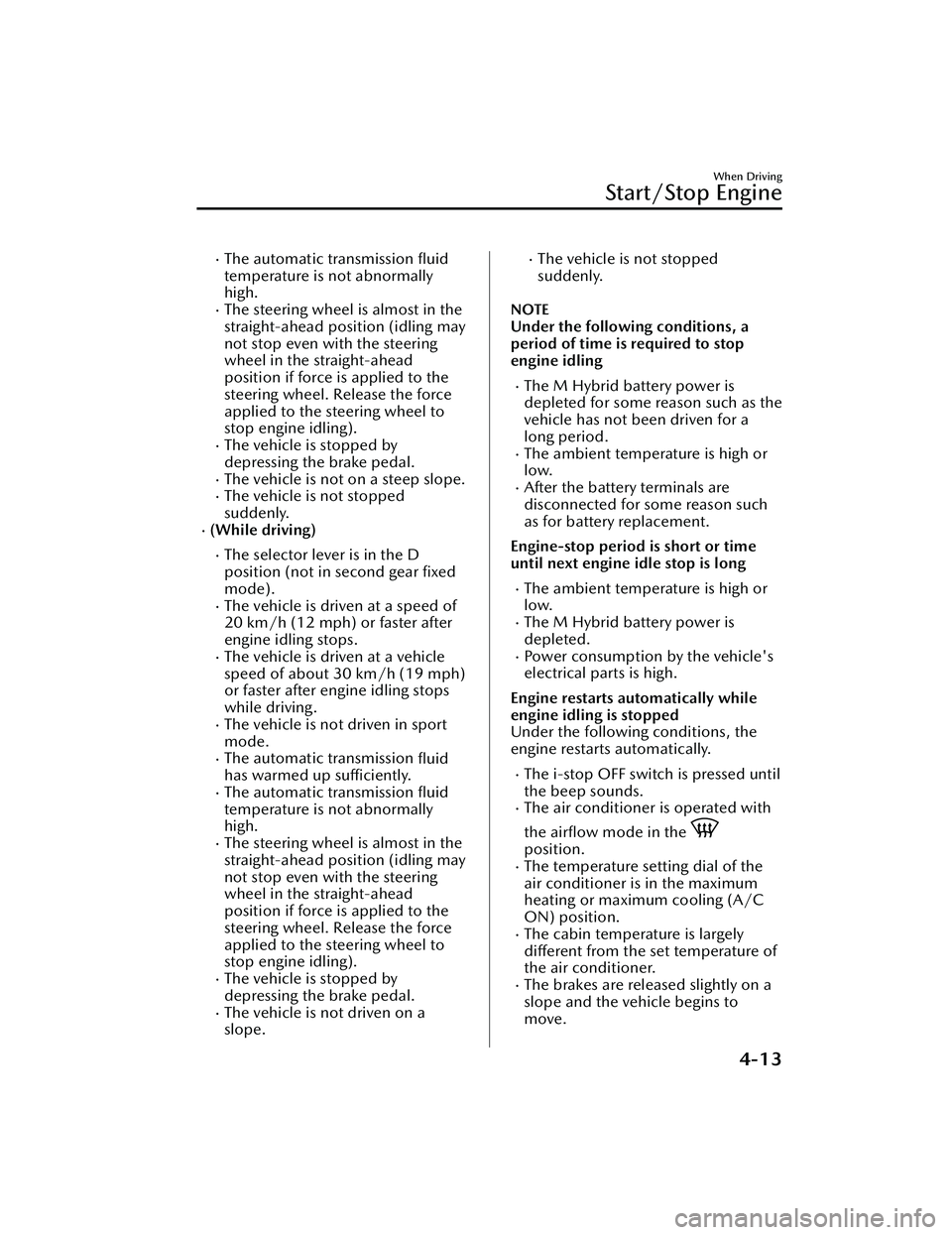
The automatic transmission fluid
temperature is not abnormally
high.
The steering wheel is almost in the
straight-ahead position (idling may
not stop even with the steering
wheel in the straight-ahead
position if force is applied to the
steering wheel. Release the force
applied to the steering wheel to
stop engine idling).
The vehicle is stopped by
depressing the brake pedal.
The vehicle is not on a steep slope.The vehicle is not stopped
suddenly.
(While driving)
The selector lever is in the D
position (not in second gear fixed
mode).
The vehicle is driven at a speed of
20 km/h (12 mph) or faster after
engine idling stops.
The vehicle is driven at a vehicle
speed of about 30 km/h (19 mph)
or faster after engine idling stops
while driving.
The vehicle is not driven in sport
mode.
The automatic transmission fluid
has warmed up sufficiently.
The automatic transmission fluid
temperature is not abnormally
high.
The steering wheel is almost in the
straight-ahead position (idling may
not stop even with the steering
wheel in the straight-ahead
position if force is applied to the
steering wheel. Release the force
applied to the steering wheel to
stop engine idling).
The vehicle is stopped by
depressing the brake pedal.
The vehicle is not driven on a
slope.
The vehicle is not stopped
suddenly.
NOTE
Under the following conditions, a
period of time is required to stop
engine idling
The M Hybrid battery power is
depleted for some reason such as the
vehicle has not been driven for a
long period.
The ambient temperature is high or
low.
After the battery terminals are
disconnected for some reason such
as for battery replacement.
Engine-stop period is short or time
until next engine idle stop is long
The ambient temperature is high or
low.
The M Hybrid battery power is
depleted.
Power consumption by the vehicle's
electrical parts is high.
Engine restarts automatically while
engine idling is stopped
Under the following conditions, the
engine restarts automatically.
The i-stop OFF switch is pressed until
the beep sounds.
The air conditioner is operated with
the airflow mode in the
position.The temperature setting dial of the
air conditioner is in the maximum
heating or maximum cooling (A/C
ON) position.
The cabin temperature is largely different from the set temperature of
the air conditioner.
The brakes are released slightly on a
slope and the vehicle begins to
move.
When Driving
Start/Stop Engine
4-13
Mazda3_8LC2-EA-22G_Edition1_new 2022-5-20 11:26:10
Page 159 of 623
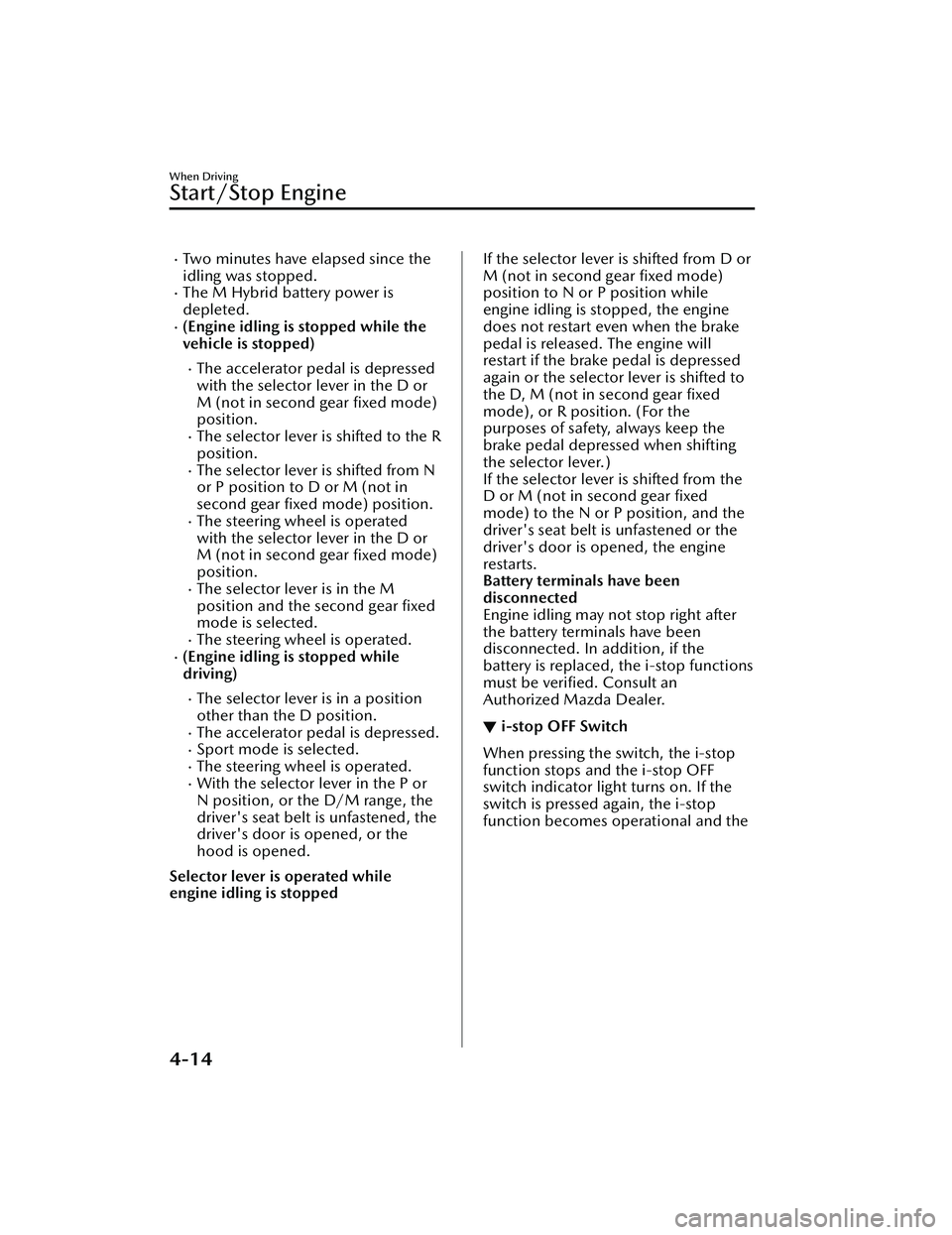
Two minutes have elapsed since the
idling was stopped.
The M Hybrid battery power is
depleted.
(Engine idling is stopped while the
vehicle is stopped)
The accelerator pedal is depressed
with the selector lever in the D or
M (not in second gear fixed mode)
position.
The selector lever is shifted to the R
position.
The selector lever is shifted from N
or P position to D or M (not in
second gear fixed mode) position.
The steering wheel is operated
with the selector lever in the D or
M (not in second gear fixed mode)
position.
The selector lever is in the M
position and the second gear fixed
mode is selected.
The steering wheel is operated.(Engine idling is stopped while
driving)
The selector lever is in a position
other than the D position.
The accelerator pedal is depressed.Sport mode is selected.The steering wheel is operated.With the selector lever in the P or
N position, or the D/M range, the
driver's seat belt is unfastened, the
driver's door is opened, or the
hood is opened.
Selector lever is operated while
engine idling is stopped
If the selector lever is shifted from D or
M (not in second gear fixed mode)
position to N or P position while
engine idling is stopped, the engine
does not restart even when the brake
pedal is released. The engine will
restart if the brake pedal is depressed
again or the selector lever is shifted to
the D, M (not in second gear fixed
mode), or R position. (For the
purposes of safety, always keep the
brake pedal depressed when shifting
the selector lever.)
If the selector lever is shifted from the
D or M (not in second gear fixed
mode) to the N or P position, and the
driver's seat belt is unfastened or the
driver's door is opened, the engine
restarts.
Battery terminals have been
disconnected
Engine idling may not stop right after
the battery terminals have been
disconnected. In addition, if the
battery is replaced, the i-stop functions
must be verified. Consult an
Authorized Mazda Dealer.
▼ i-stop OFF Switch
When pressing the switch, the i-stop
function stops and the i-stop OFF
switch indicator light turns on. If the
switch is pressed again, the i-stop
function becomes operational and the
When Driving
Start/Stop Engine
4-14
Mazda3_8LC2-EA-22G_Edition1_new
2022-5-20 11:26:10
Page 174 of 623
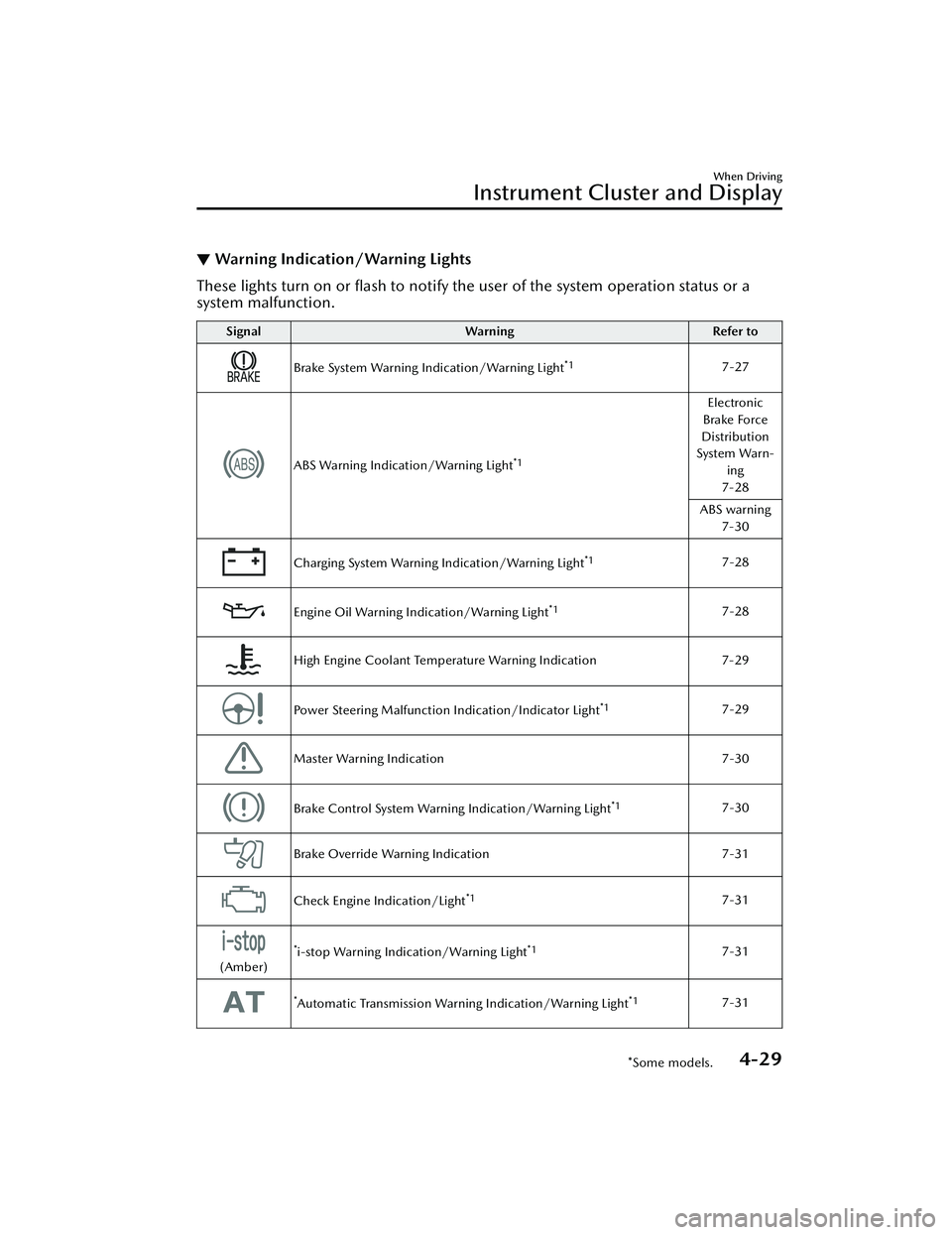
▼Warning Indication/Warning Lights
These lights turn on or flash to notify th
e user of the system operation status or a
system malfunction.
Signal Warning Refer to
Brake System Warning Indication/Warning Light*17-27
ABS Warning Indication/Warning Light*1
Electronic
Brake Force
Distribution
System Warn- ing
7-28
ABS warning 7-30
Charging System Warning Indication/Warning Light*17-28
Engine Oil Warning Indication/Warning Light*17-28
High Engine Coolant Temperature Warning Indication 7-29
Power Steering Malfunction Indication/Indicator Light*17-29
Master Warning Indication 7-30
Brake Control System Warning Indication/Warning Light*17-30
Brake Override Warning Indication 7-31
Check Engine Indication/Light*17-31
(Amber)
*i-stop Warning Indication/Warning Light*17-31
*Automatic Transmission Warning Indication/Warning Light*17-31
When Driving
Instrument Cluster and Display
*Some models.4-29
Mazda3_8LC2-EA-22G_Edition1_new 2022-5-20 11:26:10
Page 191 of 623
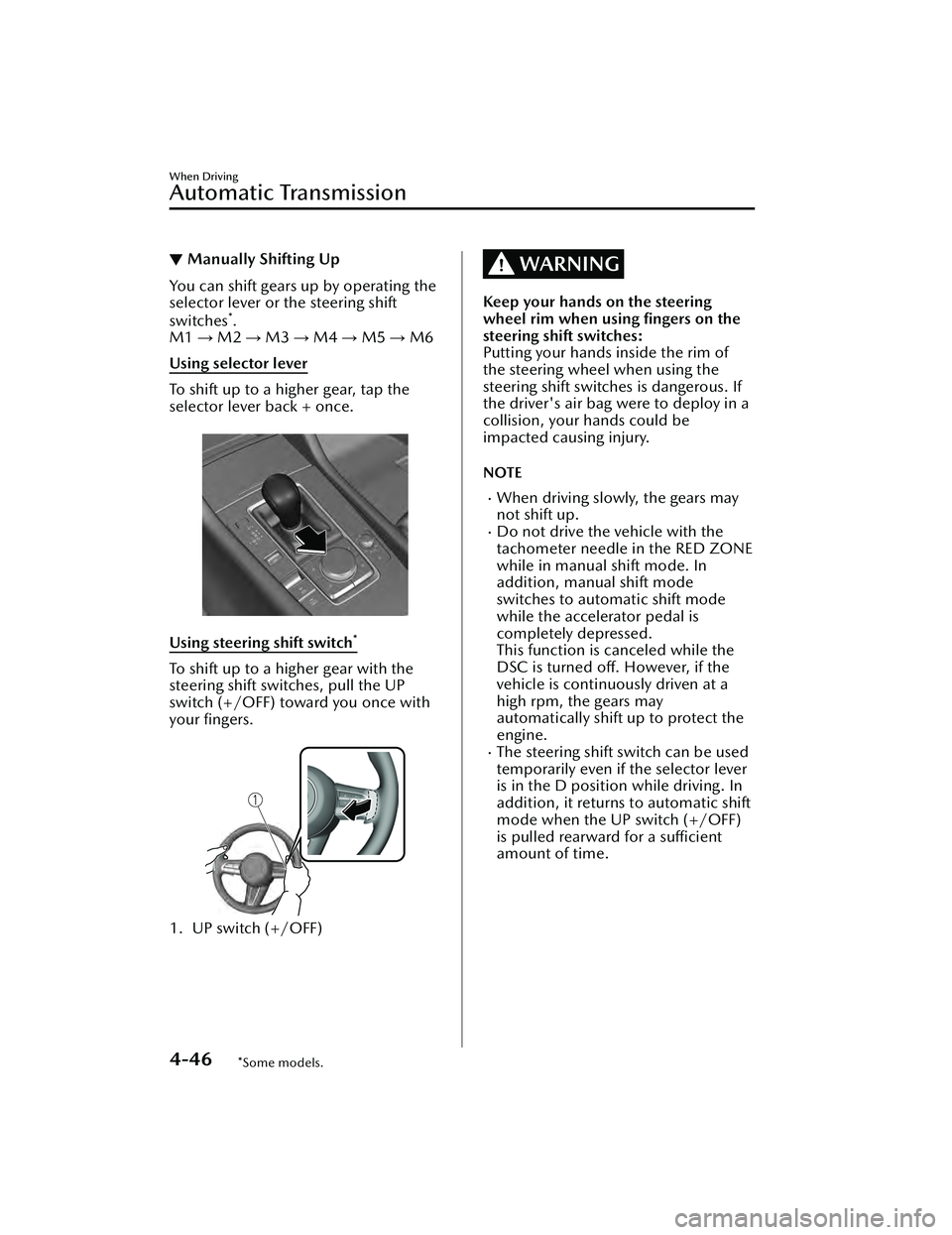
▼Manually Shifting Up
You can shift gears up by operating the
selector lever or the steering shift
switches
*.
M1 → M2 → M3 → M4 → M5 → M6
Using selector lever
To shift up to a higher gear, tap the
selector lever back + once.
Using steering shift switch*
To shift up to a higher gear with the
steering shift switches, pull the UP
switch (+/OFF) toward you once with
your fingers.
1. UP switch (+/OFF)
WARNING
Keep your hands on the steering
wheel rim when using fingers on the
steering shift switches:
Putting your hands inside the rim of
the steering wheel when using the
steering shift switches is dangerous. If
the driver's air bag were to deploy in a
collision, your hands could be
impacted causing injury.
NOTE
When driving slowly, the gears may
not shift up.
Do not drive the vehicle with the
tachometer needle in the RED ZONE
while in manual shift mode. In
addition, manual shift mode
switches to automatic shift mode
while the accelerator pedal is
completely depressed.
This function is canceled while the
DSC is turned off. However, if the
vehicle is continuously driven at a
high rpm, the gears may
automatically shift up to protect the
engine.
The steering shift switch can be used
temporarily even if the selector lever
is in the D position while driving. In
addition, it returns to automatic shift
mode when the UP switch (+/OFF)
is pulled rearward for a sufficient
amount of time.
When Driving
Automatic Transmission
4-46*Some models.
Mazda3_8LC2-EA-22G_Edition1_new 2022-5-20 11:26:10